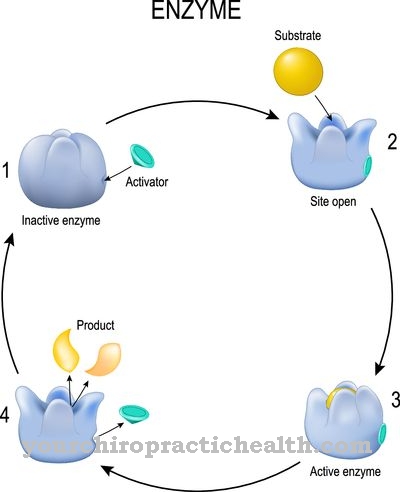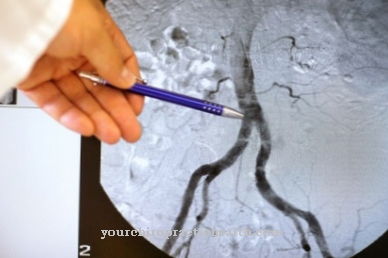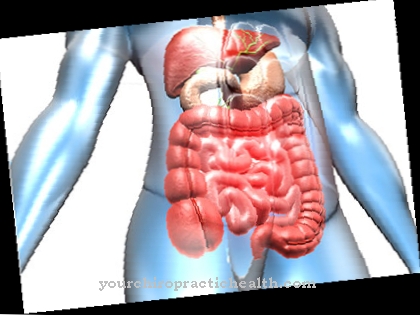Of the cardiogenic shock is a form of shock caused by poor heart pumping. It is an absolute emergency and, without immediate treatment, often results in death from heart failure. There are many causes of cardiogenic shock.
What is Cardiogenic Shock?

© peterjunaidy - stock.adobe.com
Of the cardiogenic shock is caused by failure of the heart to pump. As part of this disease process, the heart is no longer able to ensure the required cardiac output (HMV). The cardiac output defines the volume of blood that the heart pumps through the body within one minute. It is the product of heart rate and stroke volume.
The heart rate in turn denotes the heartbeats per minute. The stroke volume is the amount of blood that is pumped into the circulation by a heartbeat. The cardiac output is typically around 4.5 to 5 liters per minute. In the event of unusual loads, the HMV can increase four times. This can be caused both by increasing the heart rate and by increasing the stroke volume.
Cardiac output can drop drastically for various reasons. These causes include structural heart changes, heart valve defects, cardiac arrhythmias, high blood pressure, heart attack or stiffening of the heart walls. Cardiogenic shock is the most extreme form of decreased cardiac output. However, cardiogenic shock is only one form of shock.
In addition to cardiogenic shock, there is also volume deficiency shock, septic shock, and anaphylactic shock. However, every shock marks a life-threatening condition that is associated with an insufficient supply of oxygen to the internal organs. Regardless of the cause, the course of a shock is always the same.
causes
Cardiogenic shock is generally caused by failure of the heart. The cause is usually a previous heart disease. This suddenly reduces the volume of blood flowing through the body. As a result, there is an insufficient supply of oxygen to the organs. Due to the lack of oxygen, anaerobic degradation processes take place to a greater extent.
This metabolic pathway does not require oxygen to break down nutrients and the body's own substances. As a result, there is no complete breakdown. Among other things, acidic degradation products are formed. The body therefore becomes more and more acidic and thus fires the process even further. This acidosis causes the arterioles to sag and damage the blood capillaries. This leads to a loss of fluid, which in turn increases the hypovolemia.
In addition, blood congestion occurs in the hair vessels, which can lead to microthrombi. The entire process intensifies more and more, regardless of its cause, in the form of a vicious circle and is therefore also referred to as a so-called shock spiral. Cardiogenic shock can be caused by a heart attack, general heart failure or bradycardia, among other things.
An extreme increase in the heart rate, ischemia, arterial high blood pressure or a heart valve defect. Heart medication such as beta blockers, cytostatics or antidepressants can also trigger cardiogenic shock.
Symptoms, ailments & signs
General symptoms of shock include pallor and hypotension. Cardiogenic shock also results in shortness of breath, chest pain and congested neck veins. In addition, a greatly reduced pulse rate (bradycardia), ventricular fibrillation or pulmonary edema can occur. The difficult breathing takes place with damp rattling noises.
The systolic blood pressure is below 90 mmHg with a heart index below 1.8 l / min / m². A maximum of 1.8 liters of blood per minute flows through every square meter of the body surface. This can lead to multiple organ failure of the liver, kidneys, intestines and central nervous system. The consciousness becomes cloudy. Without treatment, cardiogenic shock can be fatal.
Diagnosis & course of disease
A state of shock can be diagnosed very quickly based on the symptoms. However, it is more difficult to determine which form of shock is present. A known heart disease and the additional symptoms that occur, such as shortness of breath or pulmonary edema, will quickly lead the doctor to the suspected diagnosis of "cardiogenic shock". After the emergency treatment of the shock, the actual treatment of the heart can begin immediately.
Complications
This shock is usually a medical emergency. If there is no immediate treatment, the patient can also die. Usually this shock causes severe shortness of breath. The patient's resilience drops significantly and the person concerned appears tired and exhausted.
It can also lead to a decreased heart rate and the affected person can continue to lose consciousness completely. The quality of life is considerably restricted and reduced by this shock. The internal organs also often no longer function properly, which can lead to organ failure in the worst case. It is not uncommon for patients to suffer from fear of death, panic attacks or sweating.
Treatment for this shock must be immediate in order for the patient to survive. Surgical interventions and medication are necessary to combat the symptoms. However, a causal treatment of this complaint is also necessary so that the underlying disease is limited and there is no new shock. Life expectancy may be reduced. Further complications depend to a large extent on the underlying disease, so that generally no general prediction is possible.
When should you go to the doctor?
If symptoms such as shortness of breath, problems with the cardiovascular system or chest pain are noticed, a doctor should always be consulted. If the symptoms appear suddenly, an emergency doctor must be called. Cardiogenic shock can be fatal if not treated in time. Therefore, a doctor must be consulted at the first signs. Medical advice is also required if signs of a shock reaction are noticed.
The first aiders should call in the emergency services and, if in doubt, provide first aid measures. Typical shock symptoms such as shortness of breath or circulatory problems should always be clarified by a doctor, regardless of whether cardiogenic shock is suspected. In addition to the family doctor, the internist or a cardiologist can be involved. It may also be useful to involve a therapist, especially if the cardiogenic shock occurred in connection with an accident or fall. Children who show signs of cardiogenic shock should be brought to the pediatrician promptly.
Treatment & Therapy
Cardiogenic shock is an emergency and needs to be treated as soon as possible. For this purpose, a percutaneous coronary intervention (PCI) takes place. Here, narrow areas are expanded with a left heart catheter. To do this, a balloon or stent is introduced via a catheter. In the presence of blood clots, systemic fibrinolysis is performed.
Fibrinolysis is an enzymatic breakdown of the fibrin, whereby the thrombi can be dissolved. In addition, emergency bypass operations must often be performed. At the same time, anticoagulant substances are administered to prevent further blood clots from forming.
The anticoagulant substances include platelet function inhibitors or thrombin inhibitors. In parallel to emergency treatment, the cardiovascular system must be stabilized. The patient should be placed in a cardiac bed. In the heart bed position, the upper body is placed high and the legs low. The aim is to reduce the venous blood flow to the heart.
In this position, the patient must be secured against slipping. The circulatory system is additionally stabilized by vascular-active substances such as dobutamine, vasodilators or noradrenaline. Intra-aortic balloon counter-pulsation is also often performed. This is a balloon pump that is often used in emergency medicine, which also improves the oxygen supply by improving the blood circulation.
Outlook & forecast
Treatment with catheter intervention and the immediate opening of the occluded coronary arteries made it possible to significantly reduce the acute mortality of patients with cardiogenic shock over the past 20 years. Early detection of cardiogenic shock is crucial for reducing acute mortality.
If the cardiogenic shock is left untreated, this leads to multiple organ failure and consequently to the death of the patient. For the further prognosis of surviving patients from cardiogenic shock, the first time immediately after discharge from the hospital seems to be particularly critical. Significantly more patients with cardiogenic shock die within the first 60 days than patients without shock. During the stay in hospital, however, the chances of survival have increased significantly in recent years. As recently as the 1980s, around 70 percent of all patients who were admitted to a hospital with cardiological shock died. Today it is around 40 percent.
Adequate therapy management and close cardiological controls can improve the short- and long-term prognosis of patients with cardiogenic shock. However, a full recovery after an extensive heart attack is usually no longer to be expected.
prevention
The best way to prevent cardiogenic shock is to prevent arteriosclerosis, which can lead to heart disease. This can be achieved through a healthy lifestyle with a balanced diet, plenty of exercise and by abstaining from alcohol and smoking.
Aftercare
In the event of such a shock, there are usually only a few follow-up measures available to the person concerned. An emergency doctor should be called quickly or a hospital visited directly so that the person concerned does not die as a result of this shock. Furthermore, the underlying illness must be treated to prevent this condition from recurring.
In many cases, however, such a shock significantly reduces the life expectancy of the person affected. In general, with this disease, the patient should take it easy and rest. In doing so, you should refrain from exertion or from stressful or physical activities in order not to unnecessarily burden the body. Furthermore, a healthy lifestyle with a healthy diet and light sporting activities can have a positive effect on the course of the disease.
After the emergency treatment, the cause of the shock must first be identified. Furthermore, the underlying disease must be restricted so that no general prediction can be made. The person concerned should have their heart examined and checked regularly by a doctor. Further follow-up measures are usually not available to the affected person. In many cases, they are heavily dependent on the underlying disease.
You can do that yourself
If cardiogenic shock occurs, first aid must be provided immediately. The first aiders should position the upper body of the person affected slightly higher. If the blood pressure is weak, the supine position is recommended, otherwise too much blood will flow into the upper body and the already damaged pump muscle will be stressed too much. If the patient is conscious, he should sit on the floor with his legs outstretched and support his upper body with his arms. It should be noted that the person concerned is not allowed to drink anything. His clothing is best loosened.
In addition to these measures, the rescue service must be called as soon as possible. If you are unconscious, chest compressions or resuscitation are indicated. After the treatment, the patient must rest for at least three to four weeks. A lifestyle change may also be necessary. Depending on the cause, your doctor may recommend a healthier diet, more exercise, and avoidance of stress. It is important to avoid stimulants in the first time after the treatment. In order to avoid another shock, the clinic should be visited regularly for check-ups.


.jpg)

.jpg)




















.jpg)


